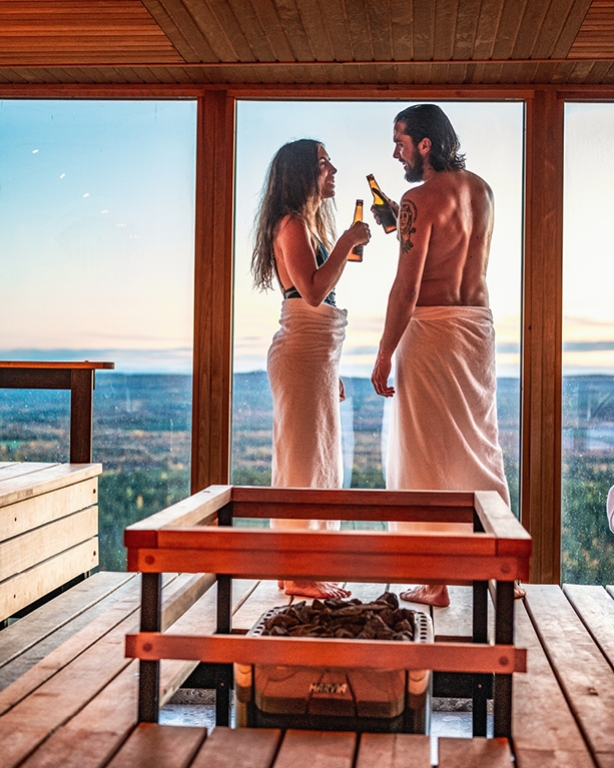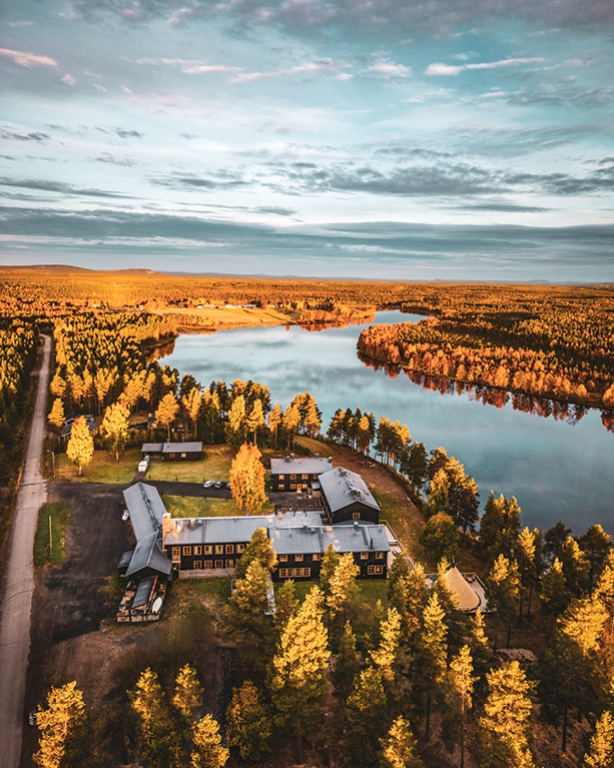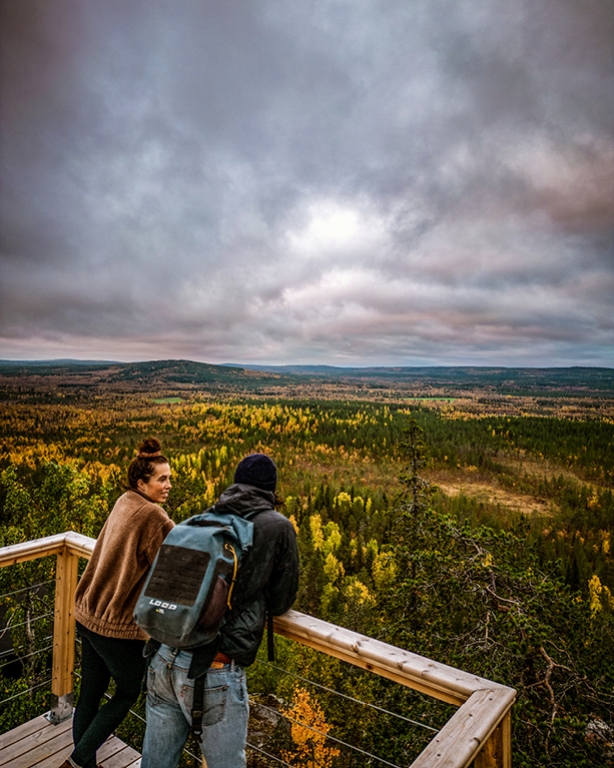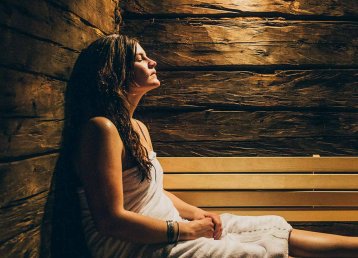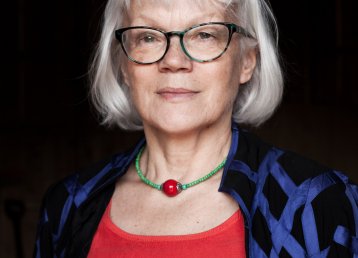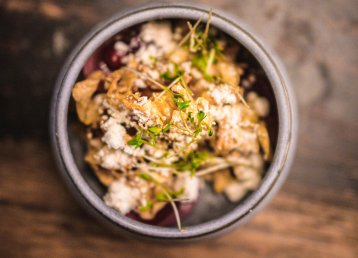The tie that binds
If you believe in the motto of Svenska Bastuakademien, The Swedish Sauna Academy, only truth prevails in the sauna. Then perhaps you have asked yourself this question: Can one find oneself in the sauna?
Let’s say that the whole trip starts on the bridge between Seskarö and the mainland. There’s a fabulous sunset and, since there is no traffic in the middle of the night, you allow yourself to pause and enjoy. In some way, it feels as if the bridge is elsewhere, not in Sweden. Your colleague says, “it’s almost as if this bridge was in Norway.” And someone else even likened Seskarö to a Swedish Key West – which may be a bit of an exaggeration. Meanwhile, you sit still in the car, marvelling at the light of the midnight sky. This is one of the summer’s many enchanting white nights and, even though it may feel as if you are somewhere else, in Norway or Florida, here is where you want to be. Perfectly still in the summer night.
Haparanda and the neighbouring Finnish border town of Tornio named themselves Eurocity. Here, the river is no border, but the tie that binds. You’ll see, hear and experience this all along your journey westward from the islands of the Bay of Bothnia to the mountain landscape surrounding Riksgränsen. Today you’ve been out to the National Park of Haparanda Archipelago, revitalized in a spa at Sweden’s easternmost mainland point, dined and slept at Stadshotellet, which dates from 1900, and taken a car ride out to Seskarö under the surreal light of the northern summer.
Also read
In sauna veritasIn times past
The following morning, you will saunter over the bridge to Tornio. Near the church is a monument commemorating Friedrich Georg Wilhelm von Struve’s expedition to chart the Geodetic Arc. This World Heritage site, the path of Struve’s survey expedition, with triangulations stretching from Odessa on the Black Sea to Fuglenes on Norway’s North Atlantic coast, tells a fabulous story that you will follow for virtually all of your trip.
Here, by the church, King Karl XI might also have seen the midnight sun in 1694. But at the stroke of midnight, clouds rolled in and blocked the sun, so the king missed the show. However, he decided to try his luck the following year and in preparation for his return, the round so-called ‘King’s Window’ was installed on the church tower. Unfortunately, the king died before he was able to return and missed out on both the midnight sun and the window.
"This is the home of Sweden’s sauna academy, and holds at least thirteen different saunas"
After a morning stroll – nowhere on the scale of Struve’s expedition – breakfast and careful consideration of whether a new item from IKEA’s northernmost outlet might be needed, your travels continue. Not much distance will be covered today. First, in Kukkola, some mustard is procured from Pesula, the world’s northernmost mustard grower, after which you take a jaunt to Struve’s Geodetic Arc before pausing for lunch: fresh-smoked whitefish at Kukkolaforsen. Bag-netting for whitefish in the rapids of Kukkola is a cultural heritage, and a more locally sourced lunch can seldom be found. Fresh fish, caught in the river, some metres away, prepared in the adjacent smokehouse and served with fresh potatoes. In addition to rapids and fishing, Kukkola has everything you desire if you’re a sauna aficionado. This is the home of Sweden’s sauna academy, and holds at least thirteen different saunas, among them, two smoke saunas. In times past, the smoke sauna, antibacterial and cleansing, was the undisputed answer to all ills. Children were born in the sauna and the departed rested here, awaiting burial. In mid life, evenings were spent here.
Also read
Haparanda to Riksgränsen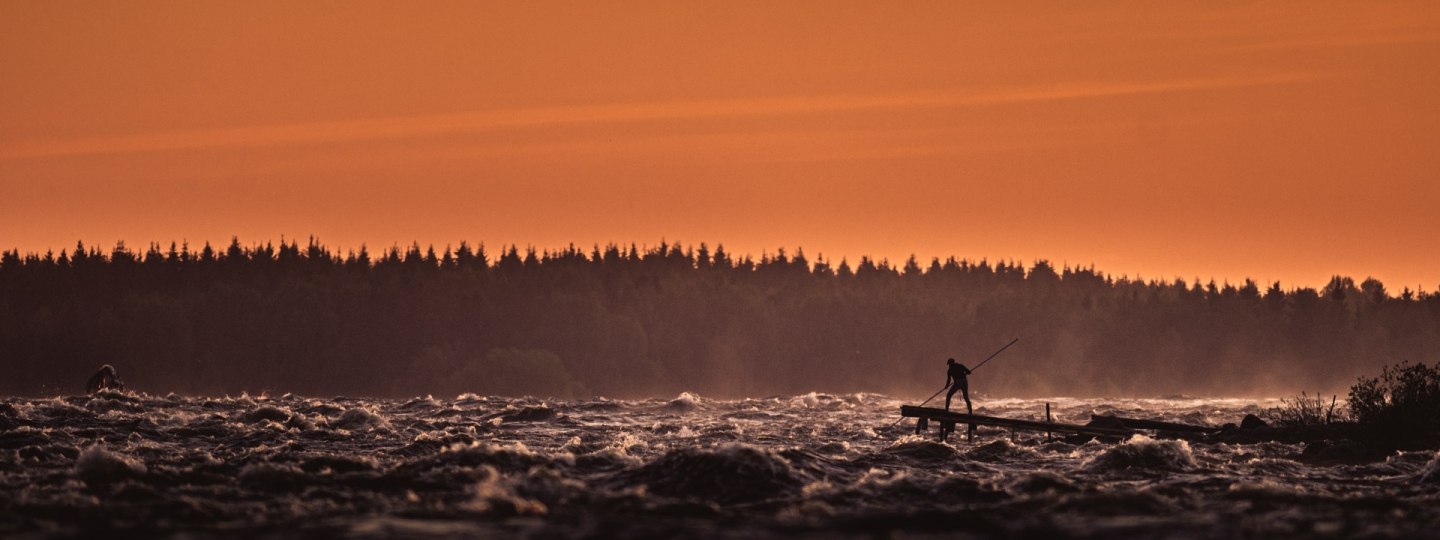
A cultural heritage
Bag-netting for whitefish in the rapids of Kukkola is a cultural heritage, and a more locally sourced lunch can seldom be found. Fresh fish, caught in the river, some metres away, prepared in the adjacent smokehouse and served with fresh potatoes.
A few more sights
That afternoon, after a sauna and a dip in the river, you continue upstream to Risudden/Vitsaniemi. Here, entrepreneur Gunhild Stensmyr, inspired by the Italian Albergho Diffuso concept, has built one the destination’s most interesting hotels; Arthotel Tornedalen. With a flair for exciting design she purchased and renovated a few of the old homesteads, bringing new life to the village. Upon reaching Arthotel, you’re in no hurry and decide to linger a while. Your next destination is Luppioberget and the recently built Lapland View Lodge. You’ll stop over, here on the mountain, admiring yet another captivating view from the comfort of yet another sauna. However, before checking in you decide to take in a few more sights.
Lake Armasjärvi is interesting from a military history point of view as the site of a major disaster in peacetime. In October 1940, 46 people (44 recruits and two civilians) perished here. They drowned in the frigid water when an overloaded ferry capsized. Historically, Tornedalen has not been far from the scene of conflict. And, although Sweden has not been at war for more than 200 years, our neighbouring countries have not been unscathed. After Armasjärvi you venture into Finland, crossing the bridge at Övertorneå to Yle-Tornio on the Finnish side, and then up the rugged Aavasaksa Hill. Here, you meet Struve once again, and you can also see Tsar Alexander II’s imperial hunting lodge, which was drawn by architect Hugo Saurén. The retreat was built for the Russian tsar, who wished to get away and enjoy the pleasures of hunting in his northern domain. But the Emperor of Russia, King of Poland and Grand Duke of Finland never got a chance to see his newly built timber lodge. At home, it was a time of turmoil, with the Crimean War raging and other problems brewing. Finally, Tsar Alexander was unlucky to die after the fourth assassination attempt succeeded.
The whitefish in Kukkola
At Kukkolaforsen Turist & Konferens, by the mighty Torne River in Swedish Lapland, you can find what’s got to be some of the freshest whitefish of the entire planet – and they are pretty spectacular. Both the whitefish and the people are serving this arctic speciality.
A history filled with visions
The next day also starts off at a relaxed tempo. Dinner and a sauna take their toll. And the view from the room on Luppioberget makes your bed an even nicer place to be. A fascinating view. You eat breakfast and pack your stuff. The journey proceeds upstream along the river. At Särkilax a chapel has been built anew after the original was washed away in the spring flood. Here, you might even climb a bird watching tower to do some birding. You drive past Svanstein, where Struve continued recording his measurements of the curvature of planet Earth up on Pullinki. But, since you’re planning to see a few more sights, the hike up Pullinki will have to wait.
"It is a history that is filled with visions, as well as tribulations"
Just before reaching Pajala, you make a brief stop at Kengisforsen. Kengis bruk, the site of an old ironworks, offers world-class salmon fishing, but is also part of the local industrial heritage and history, together with places such as Svanstein, Masungsbyn and Melderstein. It is a history that is filled with visions, as well as tribulations. After visiting Kengis, you pause for lunch at Bykrogen in Pajala, beside the world’s biggest sundial. That afternoon takes you out to the wetland meadows of Vassikavuoma, and on a short amble up the green hill of Jupukka, the fifth point of measurement on Struve’s expedition along the river valley. After a visit up on Jupukka, you drive to Arctic River Hotel in Tärendö. And, yes, there is a sauna, a tub and a whole river to bathe in.
Also read
Salmontrippin'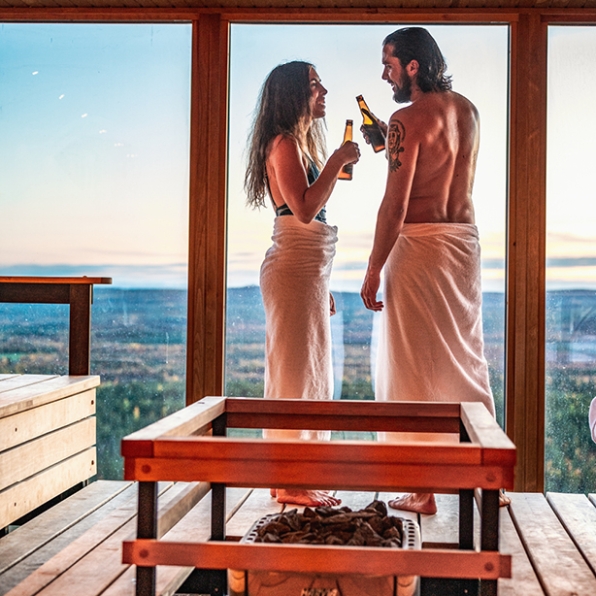
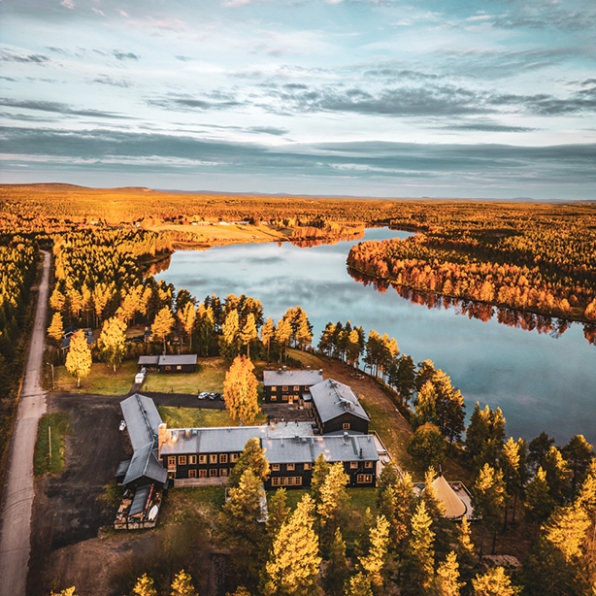
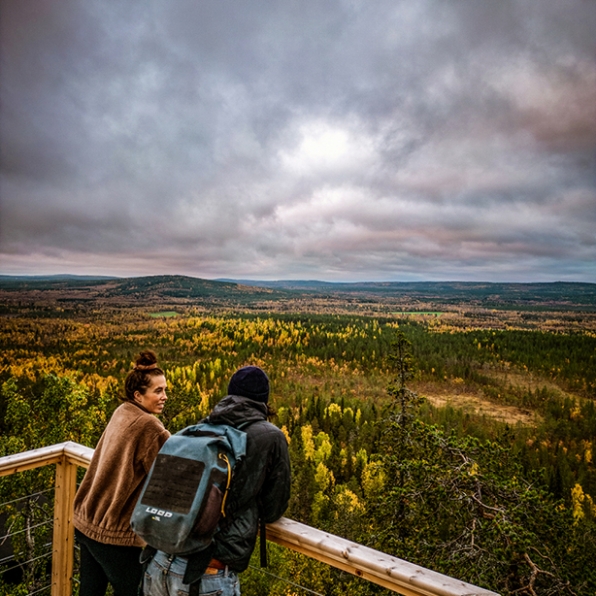

The revival movement
The Tärendö River is an attraction in itself – the world’s second-largest bifurcation, after Casiquiare in the Amazona. And what, you may ask, is a bifurcation? This means that the Tärendö receives its water, its origin, from the national Torne River, and then discharges it into another national river, the Kalix River. Beyond Pajala, there are actually two alternative routes for your onward journey through Tornedalen. But at Junosuando you take a right and drive northward, crossing the Torne River and proceeding towards Kangosfors, reaching Rd. 99 south of Muodoslompolo. This takes you past the exit to Tynnyrylaki, the northernmost Swedish point of measurement on Struve’s expedition, which then continued into Finland, and then to Fuglenes, in the Norwegian municipality of Hammerfest.
In Sweden’s northernmost church village, Karesuando, you visit both the church and a building referred to as Laestadius’s pörte. In the church, you see Bror Hjorth’s classic altarpiece. Priest Lars Levi Laestadius from Jäckvik, in Arjeplog, grew up in a dysfunctional home. After he was ordained he eventually ended up in Karesuando, where he would fight a battle against the alcohol abuse and miserable conditions which plagued many Sámi and settler families. Often, this was a result of their having been tricked into disadvantageous agreements by public officials, the clergy and unscrupulous merchants, who sweetened many a dubious deal with liquor. The revival movement, started by Laestadius, would have a deep and lasting social impact on the entire community. In Laestadius’s pörte (a kind of utility building which doubles as a smokehouse), not far from the beautiful church with Bror Hjort’s famous sculpture, you feel a sense of the simplicity of life as it once was lived here. Then, heading due south, you pass several old, and well-preserved stone bridges beside the E45 on the way to Kiruna.
Explore the north
In this film you get to follow Sarah and Tobias as they explore the north of Sweden. Way above the arctic circle they visit husky kennels, go biking in the woods, paddling on winding water ways and enjoying the Arctic cuisine.
A city on the move
It is difficult to understand ‘the new Kiruna’. It’s hard to take in the magnitude of the entire urban relocation; to comprehend how a whole town can pack up and move to a new site. But that’s exactly what is happening. Summer 2022 saw the relocation of Kiruna’s old town centre. You meet a fascinating new urban setting as you approach along the E10. You check in at Scandic Hotel, which was designed by architects SandellSandberg. On one side it’s a bit edgy and angular; on the other, more rounded. Somewhat reminiscent of the north and south sides of Giebmegáisi/Kebnekaise. Or, perhaps, one side of the building can be likened to Giebmegáisi in profile, and the other side is much like the iconic Lapponian Gate, Čuonjávággi. The top-floor bar commands a magnificent view of both the city centre and the surrounding landscape. This is such a very distinctive part of Sweden that it is in some way a provocation to lump it together with the much-clichéd term ‘Norrland’. As a place, the Arctic mining town of Kiruna really is incomparable to anything else in Sweden.
Also read
Frida Lind-OjaThe choice is yours
You stay a couple of nights in the newly reawakened town. You’ll visit Nikkaluokta, and then swing by Icehotel later in the day. Eat dinner at Mommas, have a coffee at Spis and walk through the new town which, in a way, is still a construction site and a fresh urban centre. It’s a completely different world. In the new city hall, Kristallen, drawn by architect Henning Larsen, you take the opportunity to visit Länskonstmuseet. The whole building is a great expression of architecture and culture. At Camp Ripan you experience the pleasures of an award-winning spa and enjoy a meal prepared in one of Europe’s most sustainable kitchens. Over dinner, you ponder this sauna sojourn. From Cape East on the coast via Kukkola, Arthotel Tornedalen – whose sauna by the way was created by designer Christian Halleröd – to Luppioberget and Tärendö, you have landed in Kiruna, and had a sauna at both Scandic and Camp Ripan. Tomorrow you’ll continue westward to Niehku Mountain Villa, where, of course, yet another sauna with a view awaits you.
"It’s your vacation and this journey is slow travel at its best"
Here, in the sauna, you realize that the end of your journey is approaching. From the coast to the high country, from sandy beaches to mountaintops, your roadtrip has been magical. 800 kilometres later, having enjoyed fabulous hospitality, sightseeing and a northern culture. You’re feeling the physical effects of the day’s hike up to Rissajaure (known locally as Trollsjön – Troll Lake), through the amazing Geargevággi, or Kärkevagge. But, aided by the sauna, your aching muscles start to loosen up. Making no haste, you speculate on the next day’s possibilities. You’re considering a day trip up to the mountain Njullá, with Sweden’s most iconic view of Čuonjávággi and a walk down the mountain via the canyon, in Abisko National Park. Perhaps, then and there, you’re inspired to stay just one more night. You might check in at Abisko Mountain Lodge and sit down to dinner at Fjällköket. Who knows?
The choice is yours; it’s your vacation and this journey is slow travel at its best; an opportunity to take the day just as it comes. You toss a scoopful of water on the hot stones and let the heat pinch your cheeks. Only truth prevails in the sauna and, truth be told, life is really very good right now.
















